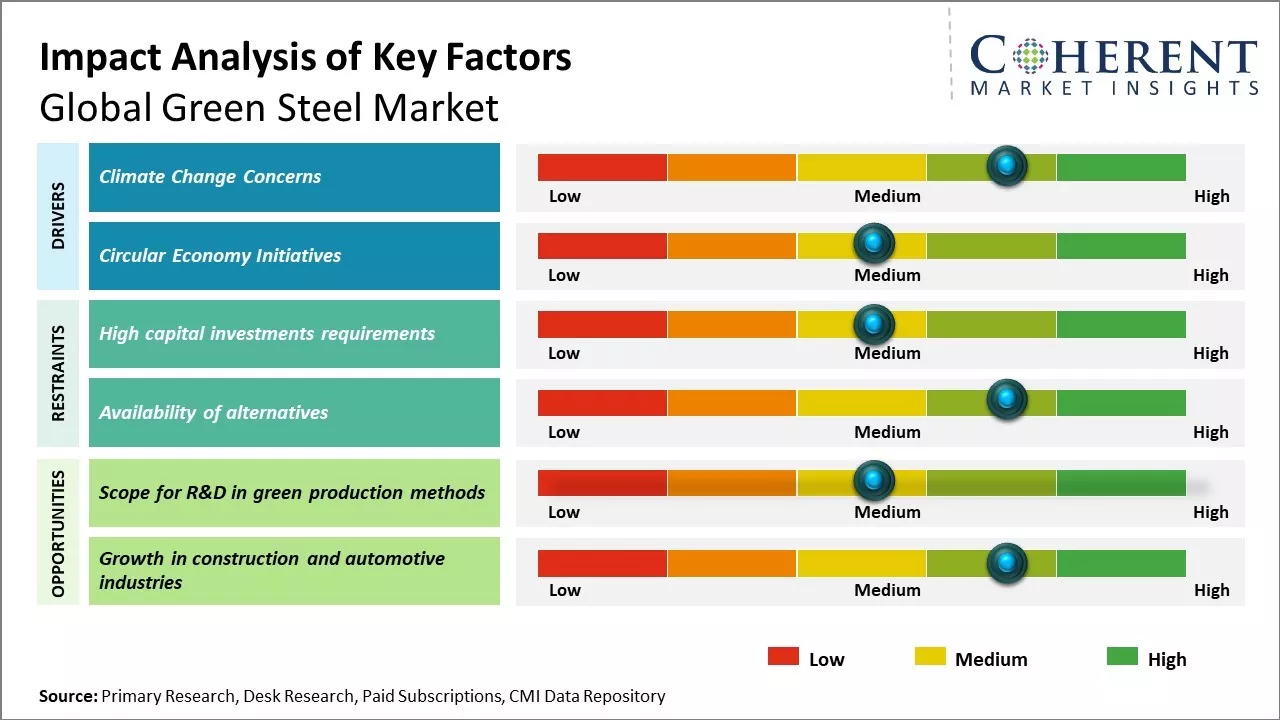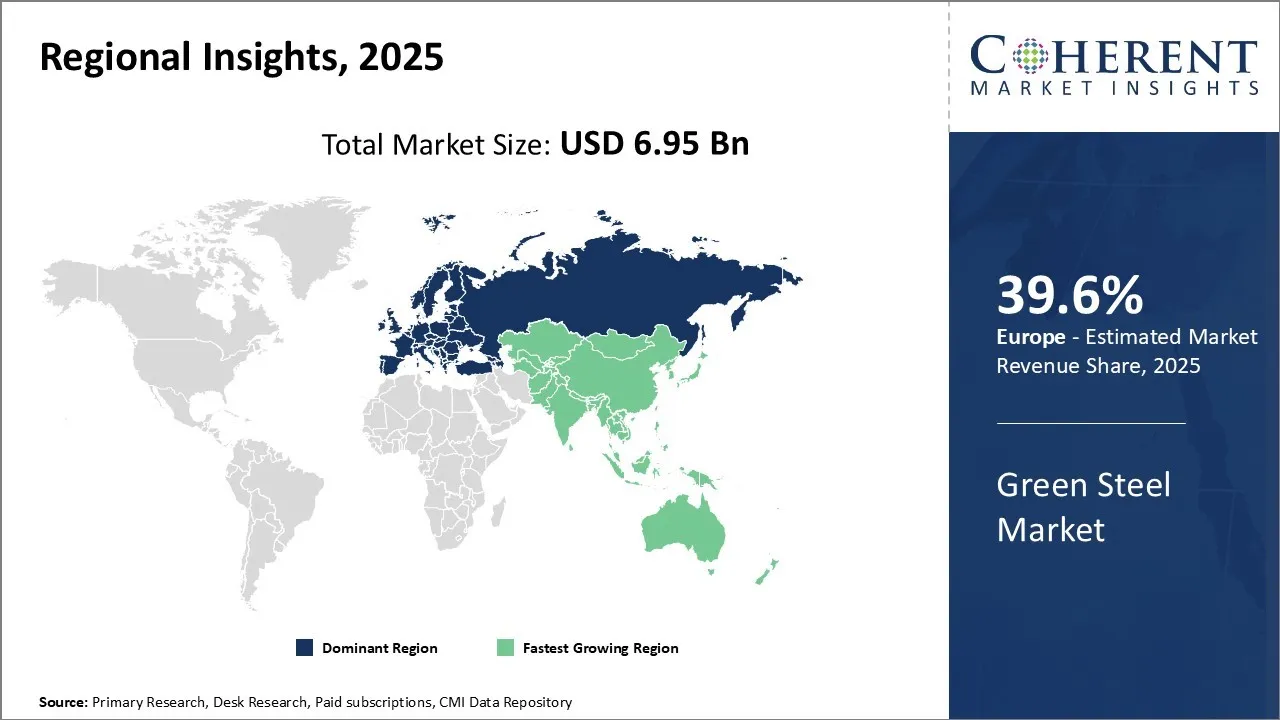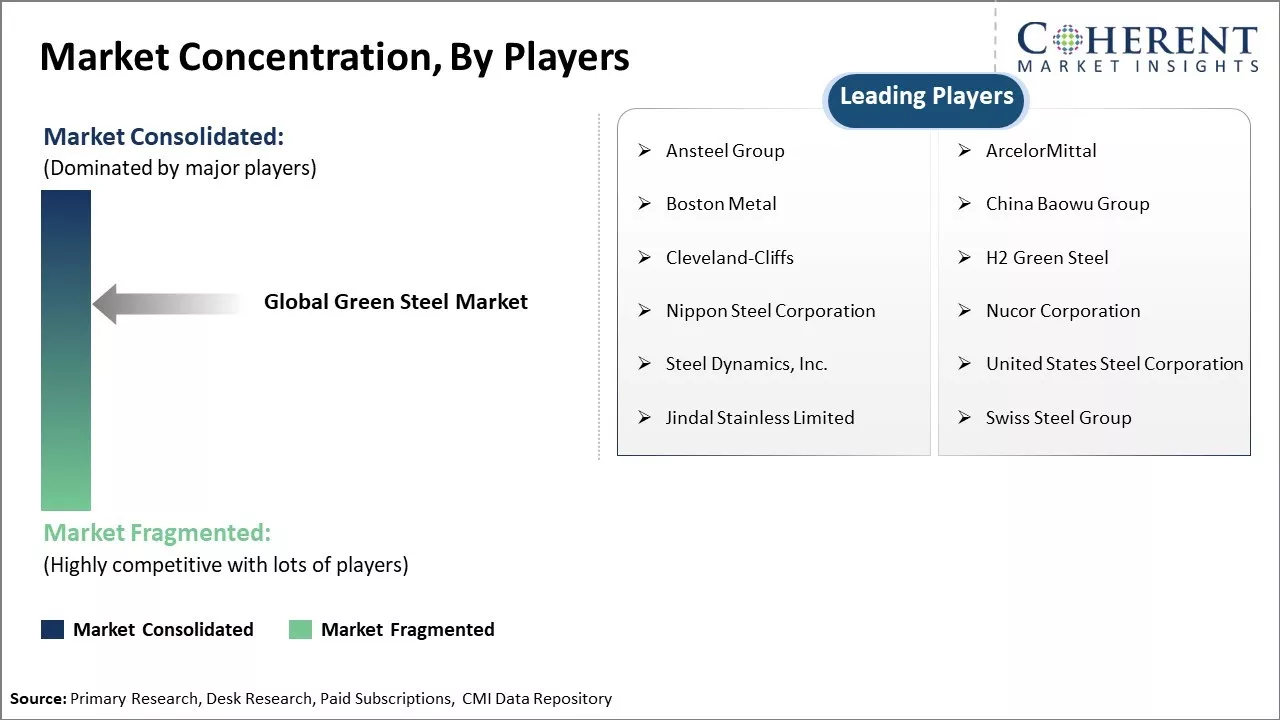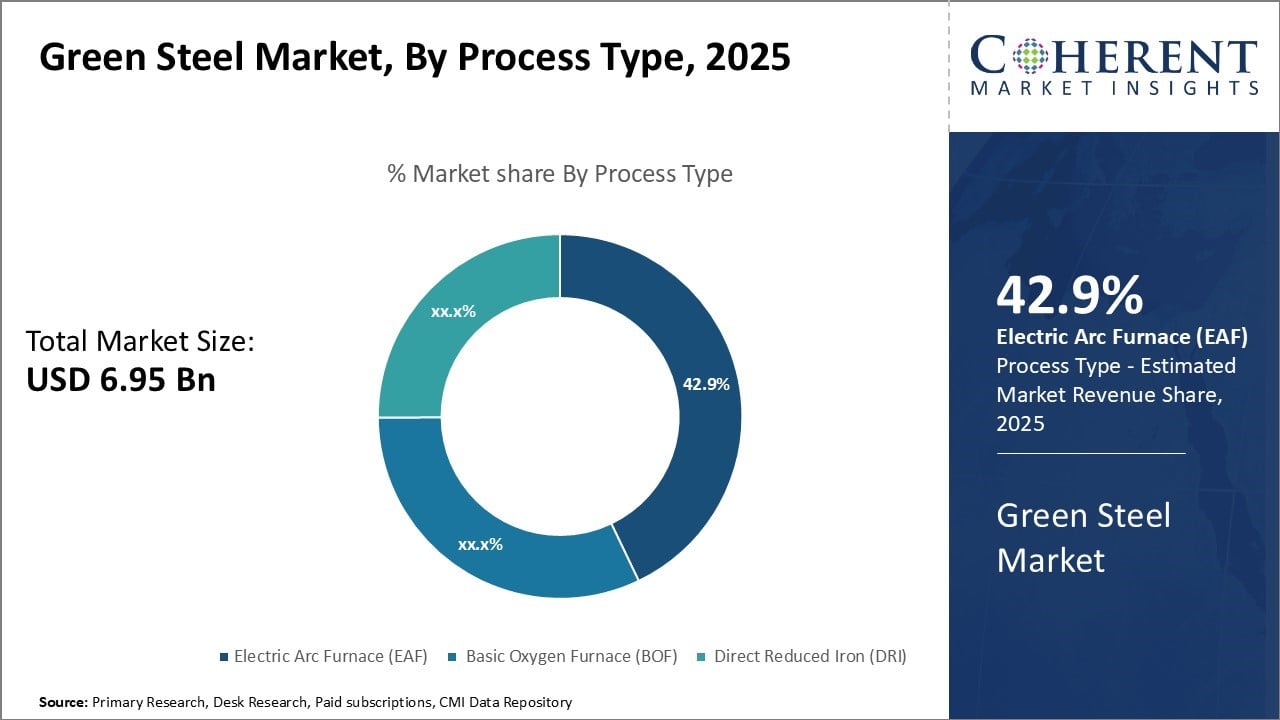Green Steel Market Size and Forecast – 2025 to 2032
The global green steel market is estimated to be valued at USD 6.95 Bn in 2025 and is expected to reach USD 189.82 Bn by 2032, exhibiting a compound annual growth rate (CAGR) of 60.4% from 2025 to 2032.

To learn more about this report, Download Free Sample
Key Takeaways
- Based on Process Type, Electric Arc Furnace (EAF) segment is projected to account for 42.9% of the global market in 2025, owing to its efficiency and versatility.
- Based on End-Use Industry, Automotive segment is expected to capture 39.2% share of the market in 2025, due to sustained demand for lightweight yet strong steel grades.
- Based on Region, Europe is set to dominate the global market with a 39.6% share in 2025.
Market Overview
Green steel production is expected to grow significantly over the next decade driven by increasing environmental regulations and focus on reducing carbon emissions globally. Many countries have committed to achieve net zero emissions by 2050 which will require industries like steel to transition to greener production methods. Major steel companies are investing heavily in transitioning their existing plants and building new facilities that utilize low carbon technologies like hydrogen reduction or electrical arc furnaces powered by renewable energy. Governments around the world are also supporting green steel development through policy push and public funding to make green steel competitive against conventional steel production
Current Events and Its Impact
|
Current Event |
Description and its Impact |
|
EU Carbon Border Adjustment Mechanism (CBAM) Implementation |
|
|
Automotive Industry's Accelerated Decarbonization Mandates |
|
Uncover macros and micros vetted on 75+ parameters: Get instant access to report
Steel Production
In FY25 (April–February), crude steel production was 137.96 MT, and finished steel production was 132.57 MT. Finished steel exports and imports were 3.60 MT and 6.07 MT, respectively, with consumption at 137.85 MT.
For FY24, crude steel production was 143.6 MT, finished steel production was 138.5 MT, and consumption stood at around 136 MT. Exports and imports of finished steel were 7.49 MT and 8.32 MT, respectively. Per-capita steel consumption in FY24 was 97.7 kg.
Looking ahead to 2030-31, steel production is expected to surpass 300 MT annually, with crude steel reaching 255 MT at 85% capacity utilization and finished steel production at 230 MT (assuming a 90% yield). Net exports are projected at 24 MT, driving consumption to 206 MT and per-capita consumption to 160 kg.
By 2030, global green steel production using hydrogen is expected to exceed 40 million metric tons. To meet net zero goals, the steel sector will need a clean hydrogen capacity of 70 million tons annually.
Green Steel Market Trend
Climate Change Concerns
Rising environmental awareness and the imminent threat of climate change has put the spotlight on reducing carbon emissions across major industries. The iron and steel sector is under immense pressure to lower its carbon footprint and transition to greener practices given its role as one of the most polluting industries in the world.
Steel manufacturing relies heavily on coal and is responsible for nearly 10% of direct carbon emissions globally. As governments and regulatory bodies implement stringent policies and regulations to achieve net-zero emission targets over the coming decades, steel producers are exploring new production methods and technologies to produce steel in an environmentally sustainable manner.
Green steel offerings, produced using low-carbon methods such as electric arc furnaces powered by renewable energy or hydrogen direct reduction processes, present an opportunity for steelmakers to reduce their carbon footprint substantially and align their operations with sustainability goals. While green steel production is currently more expensive than traditional methods, the costs are expected to decline significantly with greater investments in research and ramping up production capacities.
Major steel consuming industries are also expressing a strong preference for low-carbon steel variants to lower the carbon footprint of their own products. With sustainability becoming a key differentiator, the market demand for green steel variants from the construction, automotive, and manufacturing sectors is expected to grow considerably over the long run.
Green Steel Market Insights, by Process Type - The Dominance of Electric Arc Furnace Technology
In terms of process type, Electric Arc Furnace (EAF) is expected to contribute 42.9% share of the global green steel market owing to its efficiency and versatility. EAF allows for the easier recycling of scrap metal into new steel outputs. With rising awareness around sustainability and closed-loop manufacturing, EAF is highly attractive to steelmakers seeking to lower their environmental impact.
By using mostly scrap steel as the raw material input, EAF generates far fewer carbon emissions than traditional integrated steel mills reliant on iron ore and coke. Steel scrap is in abundant global supply as the lifecycles of vehicles, appliances, and buildings end, making EAF preferable from both an economic and environmental standpoint. Furthermore, EAF is a flexible technology that can be more easily deployed near population centers on a modular basis. This decentralization improves transportation efficiency versus transporting raw materials over long distances.
For instance, in July 2025, TATA Steel began construction of its first electric arc furnace (EAF) at the Port Talbot steelworks, marking the launch of its £1.25bn (US$1.7bn) “transformation” to low-carbon steelmaking.
Green Steel Market Insights, by End-use Industry - The Central Role of the Automotive Industry
When analyzing the end-use industry segment of the global green steel market, the automotive sector is expected to register 39.2% share in 2025, due to sustained demand for lightweight yet strong steel grades. Meeting increasingly stringent vehicle emission regulations requires automakers to pursue mass reduction through advanced high-strength steels (AHSS) and other novel alloying techniques.
Steel remains the predominant material in automotive bodies-in-white owing to its unparalleled strength-to-weight ratio and affordability relative to aluminum or composites. Continuous improvements in steel strength and formability have allowed complexity to be added to vehicle structures while keeping overall weight low. This enables compliance with toughening fuel economy and tailpipe emission norms. With most major regions now targeting net-zero emissions by 2050 or earlier, the need for lighter cars will keep demand for specialized automotive-grade steels robust.
For instance, in December 2024, Wolfsburg. Volkswagen AG and Vulcan Green Steel signed a Memorandum of Understanding (MoU) for a partnership for low-carbon steel – a key element of Volkswagen’s green steel strategy.
Regional Insights

To learn more about this report, Download Free Sample
Europe Green Steel Market Analysis & Trends
The Europe has firmly established itself as the dominant region in the global green steel market. The region is expected to account for 39.6% share in 2025. The bloc has a robust steel manufacturing industry footprint across major countries like Germany, Italy, France, and Spain. Furthermore, the European Commission has taken a clear leadership role in promoting sustainable practices and has implemented strict regulations to reduce carbon emissions from heavy industries such as steel production.
This has prompted steelmakers in the EU to increasingly invest in green technologies and processes to lower their carbon footprint. Major players have set ambitious targets to become carbon neutral in the coming years. They have invested heavily in areas like electric arc furnaces, renewable energy integration, hydrogen use, and carbon capture utilization and storage. The EU government is also providing production-linked incentives and subsidies to support steel companies in their green transition.
Swedish steel producer SSAB, together with Finnish energy firm Neste and Swedish energy company Vattenfall, is leading the development of hydrogen-based steelmaking through the HYBRIT project. This initiative aims to eliminate the use of coke by using hydrogen instead, creating the world’s first fossil-free steel.
Asia Pacific Green Steel Market Analysis & Trends
Asia Pacific represents the fastest growing regional market for green steel. Countries like China, India, Indonesia and Vietnam have huge raw material reserves and a fast-growing manufacturing sector, driving massive steel demand. However, traditional coal-based steel production methods have resulted in high pollution levels in major cities. This has forced governments in the region to support low-carbon alternatives and encourage imports of green steel to meet environmental regulations.
Green Steel Market Outlook Country-Wise
China Green Steel Market Trends
China, the world's largest steel manufacturer, has announced plans to become carbon neutral by 2060. It is now focusing on adopting European green technologies through production partnerships, joint research initiatives and engineering expertise exchanges. Other nations are also formulating long-term strategies and missions to transition existing mills and set up new greenfield projects based on low-carbon feedstocks and renewable energy.
The ASEAN countries are especially leveraging their strategic locations along major global trade routes to attract foreign investments into building import-export hubs for green building materials like steel. Their supportive investment environments and availability of low-cost production resources is attracting global steel giants to establish local manufacturing presence.
Japan Green Steel Market Trends
Japan’s green steel market is gaining momentum, driven by strong government support, corporate investment, and emerging technologies. Key steelmakers like Nippon Steel and JFE are shifting toward electric arc furnaces (EAFs) and hydrogen-based steelmaking to reduce emissions. The government’s Green Transformation (GX) strategy and subsidies are accelerating this transition.
For instance, in February 2025, Nissan Motor Co., Ltd. Announced that it will expand the use of low-CO2-emission steel manufactured in Japan. Through this initiative, the proportion of low-CO2-emission steel Nissan uses in Japan in fiscal year 2025 is expected to increase by a factor of five compared to fiscal year 2023.
Market Concentration and Competitive Landscape

To learn more about this report, Download Free Sample
Analyst Opinion (Expert Opinion)
The global green steel market is expected to grow significantly over the coming years. Driven by the rising environmental concerns and stringent CO2 emission norms worldwide, major steel producers are increasingly investing in developing green steel production technologies. Adopting hydrogen reduction instead of coke in the direct reduction of iron ore and installing carbon capture utilization and storage systems offer two major opportunities for steel mills to reduce their carbon footprint.
Huge capital investments are required for transitioning existing integrated steel plants to green technologies. High costs remain a major challenge for widespread adoption. Political will and policies supporting low carbon technologies will be crucial.
Government spending on research, carbon pricing mechanisms, and public-private partnerships can help address economic barriers. Steelmakers may gain competitive advantages by adopting green technologies ahead of regulations. Overall, the global green steel market is poised for strong growth driven by climate action though costs remain a hurdle to overcome.
Green Steel Industry News
- In February 2024- Salzgitter Flachstahl GmbH (Salzgitter), a subsidiary of Salzgitter AG and Octopus Energy’s generation arm, signed a long-term Power Purchase Agreement (PPA) to enable the future production of green steel.
- In January 2024, Kalyani Steels planned the production of green steel at a newly acquired plant.
- In May 2024, Linde signed an agreement to supply industrial gases to world’s first large-scale green steel plant.
Market Report Scope
Green Steel Market Report Coverage
| Report Coverage | Details | ||
|---|---|---|---|
| Base Year: | 2024 | Market Size in 2025: | USD 6.95 Bn |
| Historical Data for: | 2020 To 2024 | Forecast Period: | 2025 To 2032 |
| Forecast Period 2025 to 2032 CAGR: | 60.4% | 2032 Value Projection: | USD 189.82 Bn |
| Geographies covered: |
|
||
| Segments covered: |
|
||
| Companies covered: |
Ansteel Group, ArcelorMittal, Boston Metal, China Baowu Group, Cleveland-Cliffs, H2 Green Steel, Nippon Steel Corporation, Nucor Corporation, Steel Dynamics, Inc., United States Steel Corporation, Jindal Stainless Limited, and Swiss Steel Group |
||
| Growth Drivers: |
|
||
| Restraints & Challenges: |
|
||
Uncover macros and micros vetted on 75+ parameters: Get instant access to report
Market Opportunities: Scope for R&D in green production methods
Scope for R&D in green production methods could open up significant opportunities in the global green steel market going forward. As the world transitions towards more sustainable industries and innovation in green technologies progresses rapidly, investing in innovative R&D for cleaner steel manufacturing will put companies at the forefront of this global shift. Forward-thinking steel majors are already developing breakthrough technologies that could reduce carbon emissions and transform the industry's environmental impact.
For instance, companies are researching production methods that utilize green hydrogen instead of coal in the direct reduction of iron ore process. Successful implementation of hydrogen-based steelmaking would allow the transformation of the sector into a renewable industry. However, perfecting cost-effective methods to produce steel while emitting minimal carbon remains a challenging scientific problem. Significant investments and cross-industry collaborations will be needed to bring more such early-stage technologies to commercial viability over the next decade.
Market Segmentation
- Process Type Insights (Revenue, USD Bn, 2020 - 2032)
- Electric Arc Furnace (EAF)
- Basic Oxygen Furnace (BOF)
- Direct Reduced Iron (DRI)
- End-use Industry Insights (Revenue, USD Bn, 2020 - 2032)
- Construction
- Automotive
- Machinery
- Others (Shipbuilding, Appliances, etc.)
- Regional Insights (Revenue, USD Bn, 2020 - 2032)
- North America
- U.S.
- Canada
- Latin America
- Brazil
- Argentina
- Mexico
- Rest of Latin America
- Europe
- Germany
- U.K.
- Spain
- France
- Italy
- Russia
- Rest of Europe
- Asia Pacific
- China
- India
- Japan
- Australia
- South Korea
- ASEAN
- Rest of Asia Pacific
- Middle East & Africa
- GCC Countries
- Israel
- Rest of Middle East & Africa
- Key Players Insights
- Ansteel Group
- ArcelorMittal
- Boston Metal
- China Baowu Group
- Cleveland-Cliffs
- H2 Green Steel
- Nippon Steel Corporation
- Nucor Corporation
- Steel Dynamics, Inc.
- United States Steel Corporation
- Jindal Stainless Limited
- Swiss Steel Group
Sources
Primary Research Interviews
- Steel Manufacturing Company Executives
- Green Technology Solution Providers
- Hydrogen Suppliers and Technology Developers
- Renewable Energy Companies in Steel Sector
- Others
Databases
- World Steel Association (WSA) Statistical Database
- International Energy Agency (IEA) Steel Database
- BloombergNEF Clean Energy Database
- Steel Business Briefing Database
- Others
Magazines
- Steel Times International
- Metal Bulletin Magazine
- Iron & Steel Technology Magazine
- Green Steel World Magazine
- Others
Journals
- Journal of Cleaner Production
- International Journal of Hydrogen Energy
- Steel Research International
- Others
Newspapers
- Financial Times (Steel & Mining Section)
- Reuters (Industrial News)
- The Wall Street Journal (Energy & Materials)
- Bloomberg News (Commodities)
- Others
Associations
- World Steel Association (WSA)
- International Iron and Steel Institute
- Green Steel Initiative
- European Steel Association (EUROFER)
- Others
Public Domain Sources
- International Energy Agency (IEA) Reports
- United Nations Industrial Development Organization (UNIDO)
- European Commission Climate Action Reports
- Government Steel Industry Publications
- Others
Proprietary Elements
- CMI Data Analytics Tool
- Proprietary CMI Existing Repository of information for last 8 years
*Definition: Green steel refers to steel production methods that aim to reduce the environmental impact and carbon emissions compared to traditional steel manufacturing processes.
Share
Share
About Author
Yash Doshi is a Senior Management Consultant. He has 12+ years of experience in conducting research and handling consulting projects across verticals in APAC, EMEA, and the Americas.
He brings strong acumen in helping chemical companies navigate complex challenges and identify growth opportunities. He has deep expertise across the chemicals value chain, including commodity, specialty and fine chemicals, plastics and polymers, and petrochemicals. Yash is a sought-after speaker at industry conferences and contributes to various publications on topics related commodity, specialty and fine chemicals, plastics and polymers, and petrochemicals.
Missing comfort of reading report in your local language? Find your preferred language :
Transform your Strategy with Exclusive Trending Reports :
Frequently Asked Questions
EXISTING CLIENTELE
Joining thousands of companies around the world committed to making the Excellent Business Solutions.
View All Our Clients

